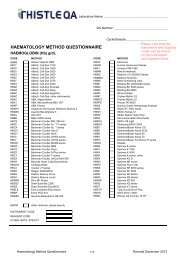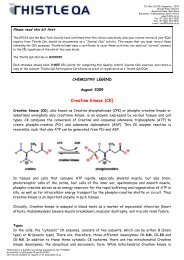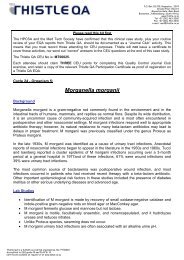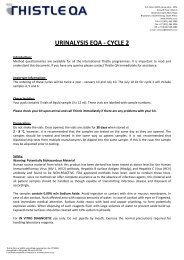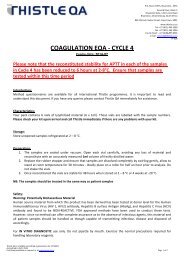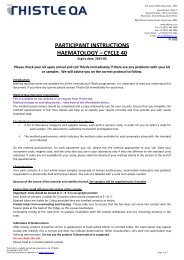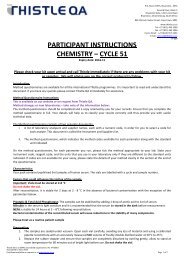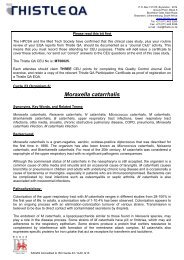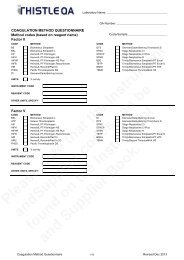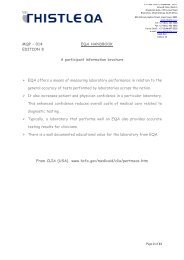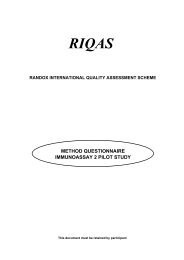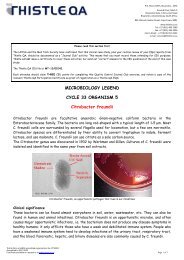What to do if your EQA results are not good - Thistle QA
What to do if your EQA results are not good - Thistle QA
What to do if your EQA results are not good - Thistle QA
You also want an ePaper? Increase the reach of your titles
YUMPU automatically turns print PDFs into web optimized ePapers that Google loves.
P.O. Box 131375, Bryans<strong>to</strong>n, 2074<br />
Ground Floor, Block 5<br />
Bryans<strong>to</strong>n Gate, Main Road<br />
Bryans<strong>to</strong>n, Johannesburg, South Africa<br />
www.thistle.co.za<br />
Tel: +27 (011) 463 3260<br />
Fax: +27 (011) 463 3036<br />
e-mail : mail@thistle.co.za<br />
Foreword<br />
<strong>What</strong> <strong>to</strong> <strong>do</strong> <strong>if</strong> <strong>your</strong> <strong>E<strong>QA</strong></strong> <strong>results</strong> <strong>are</strong> <strong>not</strong> <strong>good</strong><br />
By Jim McCulloch, of <strong>Thistle</strong> <strong>QA</strong><br />
It has often been said that “Oh, well, here comes Jim again. Biased about QC as usual.” Too right! Jim is<br />
indeed biased when it comes <strong>to</strong> producing <strong>good</strong> quality <strong>results</strong> for those who depend upon our service –<br />
the poor, sick patient. When all labs in South Africa <strong>are</strong> delivering <strong>good</strong> quality <strong>results</strong> <strong>to</strong> their patients,<br />
Jim will s<strong>to</strong>p beating his QC drum. Until then, read on…<br />
And <strong>do</strong>n’t forget that <strong>Thistle</strong> <strong>QA</strong> is an international company. The graph below shows you the<br />
distribution of labs whose <strong>results</strong> <strong>are</strong> entered on<strong>to</strong> our database, through cooperation with Ran<strong>do</strong>x in the<br />
UK.<br />
African labs comprise about 10% of our database, with most <strong>results</strong> coming from European labs. Based<br />
in Johannesburg, but fully international, that’s <strong>Thistle</strong> <strong>QA</strong>.<br />
Introduction<br />
This article will discuss a Root Cause Analysis (RCA) approach <strong>to</strong> solving poor performance on an <strong>E<strong>QA</strong></strong><br />
programme. RCA is a way of working backwards once you see you have a problem, <strong>to</strong> work out what<br />
basically – at the “root” – caused it in the first place. It is <strong>not</strong> an attempt <strong>to</strong> lay blame anywhere; rather it<br />
is a sensible approach <strong>to</strong> try and ident<strong>if</strong>y what went wrong, in the hope that it can be solved. In quality,<br />
the aim is always <strong>to</strong> solve a problem – that is, s<strong>to</strong>p it happening again.<br />
SANAS Accredited <strong>to</strong> ISO Guide 43 / ILAC G13
If <strong>your</strong> <strong>E<strong>QA</strong></strong> looks poor, or bad, or unacceptable, the problem lies either with:<br />
• Your lab,<br />
• Your supplier of instrument or reagent,<br />
• Your <strong>E<strong>QA</strong></strong> company, i.e. <strong>Thistle</strong> <strong>QA</strong>.<br />
This article will suggest a cooperative approach <strong>to</strong> deal with the investigation of unsatisfac<strong>to</strong>ry<br />
performance on an <strong>E<strong>QA</strong></strong> programme.<br />
The final outcome should be a cooperative approach between labs, suppliers and <strong>Thistle</strong> <strong>QA</strong>, <strong>to</strong> prevent<br />
problem-dumping, where each of the three blames a<strong>not</strong>her. <strong>Thistle</strong> <strong>QA</strong> almost always has extra samples<br />
available, for both labs and suppliers, at no cost, for testing. This should allow labs <strong>to</strong> <strong>do</strong>uble check their<br />
performance; and encourage suppliers <strong>to</strong> check potentially poor performance.<br />
Ideally, a supplier should ask for samples <strong>to</strong> test an instrument before it is launched locally. We <strong>do</strong>n’t<br />
charge for these samples because this is an ideal opportunity for suppliers <strong>to</strong> ident<strong>if</strong>y potential problems<br />
long before clients become concerned by poor <strong>E<strong>QA</strong></strong> reports. Insist that <strong>your</strong> suppliers use this free<br />
service. If someone is asking you <strong>to</strong> buy or evaluate a new kit or instrument – ask them how it performs<br />
with <strong>Thistle</strong> <strong>QA</strong> samples.<br />
Have you a problem<br />
<strong>E<strong>QA</strong></strong> is a vital element of a quality system. It ensures that labs have an independent, external<br />
assessment of their testing performance. Good performance on an <strong>E<strong>QA</strong></strong> satisfies the lab itself that it has<br />
a robust testing system; it satisfies clients and users that such a system exists; and it allows the lab <strong>to</strong><br />
demonstrate an acceptable quality system <strong>to</strong> accreditation assessors.<br />
Routine moni<strong>to</strong>ring of all <strong>E<strong>QA</strong></strong> <strong>results</strong> allows a lab <strong>to</strong> ident<strong>if</strong>y performance trends and other problems<br />
related <strong>to</strong> performance dr<strong>if</strong>t, imprecision and systematic or ran<strong>do</strong>m errors.<br />
<strong>Thistle</strong> <strong>QA</strong> has many ways <strong>to</strong> help participating labs interpret their reports. Instruction <strong>do</strong>cuments, QC<br />
courses and telephonic support <strong>are</strong> available and all clients <strong>are</strong> encouraged <strong>to</strong> use them. The QC course<br />
in particular should be used, both for its important information, and also for the CPD points it carries. It is<br />
available free of charge <strong>to</strong> anyone, at www.thistle.co.za, under the education section. Four modules <strong>are</strong><br />
available for self- or group-assessment. Once you finish a module, ask us for the answer sheet.<br />
And remember, all help is given confidentially. We will help anyone asking for assistance. Our mission is<br />
<strong>to</strong> help improve the quality of labora<strong>to</strong>ry testing in Africa.<br />
Understand the basics<br />
Review <strong>your</strong> <strong>E<strong>QA</strong></strong> report <strong>to</strong> confirm that the <strong>results</strong> we show you sent in <strong>are</strong> correct. If you’re <strong>not</strong> sure –<br />
ask us for help. Then, consider the following:<br />
• Have we got <strong>your</strong> correct method/ instrument code on file<br />
• Did you receive the material in satisfac<strong>to</strong>ry condition<br />
• Did you test the correct sample<br />
• Did you prep<strong>are</strong> the sample according <strong>to</strong> <strong>Thistle</strong> <strong>QA</strong> instructions<br />
• Have you changed <strong>your</strong> method/ instrument without telling us<br />
• Did you follow <strong>your</strong> established lab procedure<br />
• Was the instrument operated according <strong>to</strong> <strong>your</strong> SOPs<br />
SANAS Accredited <strong>to</strong> ISO Guide 43 / ILAC G13
• Has the maintenance been performed appropriately<br />
• Was <strong>your</strong> internal QC acceptable at the time of testing the <strong>E<strong>QA</strong></strong> sample<br />
• Has this problem occurred previously with <strong>E<strong>QA</strong></strong> samples<br />
• Did repeat testing on the <strong>E<strong>QA</strong></strong> sample produce similar <strong>results</strong><br />
• Were patient <strong>results</strong> acceptable at the time of <strong>E<strong>QA</strong></strong> testing<br />
The above list is the preliminary step <strong>to</strong>wards investigating app<strong>are</strong>nt poor performance. If you follow this,<br />
any subsequent complaint or request for help from either <strong>your</strong> instrument supplier or <strong>Thistle</strong> <strong>QA</strong>, will be<br />
taken seriously.<br />
Ident<strong>if</strong>y root cause<br />
Often, the first cause ident<strong>if</strong>ied in problem solving is a symp<strong>to</strong>m of a deeper problem. The true or root<br />
cause is <strong>not</strong> always obvious.<br />
The simplest form of RCA is <strong>to</strong> brain-s<strong>to</strong>rm the problem with <strong>your</strong> technical staff – and <strong>to</strong> keep asking<br />
“why” until you have found the underlying issues.<br />
The following table breaks the problem <strong>are</strong>as in<strong>to</strong> three: <strong>your</strong> lab; <strong>your</strong> supplier; <strong>your</strong> <strong>E<strong>QA</strong></strong> company.<br />
Lab issues<br />
Supplier<br />
issues<br />
Clerical Method Technical Instrument/<br />
reagent<br />
Mislabelled vials Wrong reference range Samples mixed up Problems<br />
used<br />
on bench<br />
with data<br />
processing<br />
Transcription<br />
error between<br />
bench and <strong>E<strong>QA</strong></strong><br />
report<br />
Incorrect<br />
instrument/<br />
method code<br />
Incorrect units or<br />
misplaced<br />
decimal points<br />
Calculations or<br />
conversions error<br />
Results <strong>to</strong>o close <strong>to</strong><br />
detection limit<br />
Internal controls <strong>do</strong> <strong>not</strong><br />
cover the detectable<br />
range<br />
Inappropriate method<br />
Method lacks sensitivity<br />
or spec<strong>if</strong>icity<br />
<strong>E<strong>QA</strong></strong> material<br />
improperly<br />
prep<strong>are</strong>d or s<strong>to</strong>red<br />
Standards/<br />
reagents <strong>not</strong><br />
properly<br />
reconstituted or<br />
expired<br />
Incorrect sample<br />
volume used<br />
Internal QC<br />
material outdated<br />
or badly s<strong>to</strong>red<br />
SOPs <strong>not</strong> followed<br />
Poor water quality<br />
function<br />
Problems in<br />
manufacture<br />
of reagents/<br />
standards<br />
Carryover<br />
from the<br />
previous<br />
sample<br />
Block in the<br />
instrument<br />
tubing/<br />
delivery<br />
system<br />
Electrical<br />
problems<br />
Material<br />
<strong>Thistle</strong> <strong>QA</strong> issues<br />
Interfering<br />
substances<br />
Nonhomogenous<br />
material<br />
Contamination<br />
Material<br />
transport<br />
problems<br />
Material<br />
improperly<br />
s<strong>to</strong>red<br />
Insufficient<br />
sample<br />
Stats<br />
Peer group<br />
incorrect<br />
Incorrect<br />
data entry<br />
Narrow<br />
Acceptable<br />
range<br />
(clinical<br />
CV)<br />
No<br />
participant<br />
consensus<br />
Incorrect<br />
method<br />
code<br />
assigned<br />
SANAS Accredited <strong>to</strong> ISO Guide 43 / ILAC G13
A more detailed analysis of this table shows that the major <strong>are</strong>as of concern <strong>are</strong>:<br />
The lab can mix up samples, make transcription errors, <strong>not</strong> prep<strong>are</strong> reagents or standards correctly,<br />
or make calculation/ unit errors.<br />
The instrument supplier can supply you with poor quality reagents, e.g. <strong>not</strong> FDA approved, or<br />
poorly train <strong>your</strong> staff in instrument operation.<br />
<strong>Thistle</strong> <strong>QA</strong> could send you poor quality samples, or group you incorrectly for stats analysis.<br />
Consider all of these potential sources of error when you <strong>do</strong> RCA!<br />
Action plan<br />
Corrective action <strong>to</strong> solve an app<strong>are</strong>nt <strong>E<strong>QA</strong></strong> problem needs <strong>to</strong> be <strong>to</strong> a degree appropriate <strong>to</strong> the<br />
magnitude of the problem. More simply, you need <strong>to</strong> assess the size of the problem. And <strong>do</strong>n’t panic.<br />
First ask<br />
Ask us for help. We never advise rapid action unless the error is clear-cut and is affecting <strong>your</strong> patient<br />
<strong>results</strong>. Otherwise, we advise a methodical approach <strong>to</strong> solving quality problems, involving the following<br />
steps.<br />
• Is the error only seen on <strong>E<strong>QA</strong></strong><br />
• Have <strong>your</strong> internal controls changed lately<br />
• Do you agree with other labs using the same equipment <strong>What</strong> <strong>do</strong>es <strong>your</strong> instrument supply<br />
company say about this<br />
• Have you asked <strong>Thistle</strong> <strong>QA</strong> for repeat samples<br />
• Have you asked <strong>Thistle</strong> <strong>QA</strong> for a detailed statistical analysis of the problem<br />
• Is the d<strong>if</strong>ference you see clinically sign<strong>if</strong>icant<br />
• Do patient correlations. Do <strong>your</strong> patient <strong>results</strong> agree with a<strong>not</strong>her lab that shows <strong>good</strong> quality<br />
<strong>E<strong>QA</strong></strong> performance<br />
Where errors take place<br />
SANAS Accredited <strong>to</strong> ISO Guide 43 / ILAC G13
This graph should act as a reminder that errors take place anywhere in a lab – <strong>if</strong> we need reminded<br />
about this! Most errors take place BEFORE the sample even reaches the bench, in the “reception” or<br />
pre-analytical <strong>are</strong>a, for a variety of reasons. This could also apply <strong>to</strong> <strong>your</strong> <strong>E<strong>QA</strong></strong> sample, so <strong>do</strong>n’t forget <strong>to</strong><br />
look well beyond the analytical part of <strong>your</strong> lab.<br />
Final message<br />
<strong>Thistle</strong> <strong>QA</strong> is <strong>not</strong> simply there <strong>to</strong> ident<strong>if</strong>y problems. We <strong>are</strong> part of the solution.<br />
We would like <strong>to</strong> work with <strong>your</strong> instrument or reagent supply company <strong>to</strong> make sure that we all work<br />
<strong>to</strong>gether <strong>to</strong> help solve the problem. It <strong>do</strong>esn’t help <strong>if</strong> we all dig trenches and lob grenades at each other.<br />
Samples <strong>are</strong> available from our s<strong>to</strong>ck for you <strong>to</strong> repeat <strong>your</strong> testing, <strong>to</strong> see <strong>if</strong> it’s a single sampling<br />
problem, or repeatable. Also, we encourage all suppliers of reagents and instrument <strong>to</strong> ask us for<br />
samples. They can <strong>do</strong> this when they <strong>are</strong> about <strong>to</strong> introduce a new instrument in<strong>to</strong> the South African<br />
market, or when some problems <strong>are</strong> seen on an <strong>E<strong>QA</strong></strong>. Either way, we want <strong>to</strong> work with local suppliers <strong>to</strong><br />
ensure that errors <strong>are</strong> fixed simply and quickly.<br />
This will cut <strong>do</strong>wn hassles <strong>to</strong> you in the labora<strong>to</strong>ry; and make sure that patients always receive the<br />
service they deserve – a <strong>good</strong> quality result that ensures our referring clinician can practice <strong>good</strong><br />
medicine.<br />
Patients deserve quality.<br />
SANAS Accredited <strong>to</strong> ISO Guide 43 / ILAC G13



